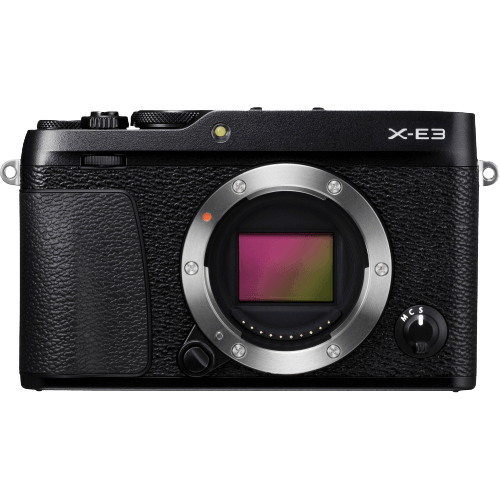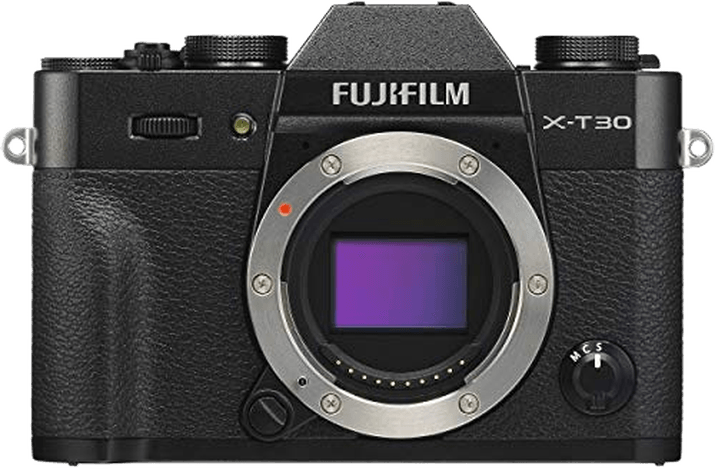Fujifilm X-E3 vs X-T30 Comparison
Fujifilm X-E3

Fujifilm X-T30

The Fujifilm X-T30 takes the lead with a score of 65/100, just two points ahead of the Fujifilm X-E3 at 63/100. Both mirrorless cameras were launched at the same price of $899. They share similarities in camera type and launch price.
The X-T30, released in 2019, edges ahead with its compact size of 118 x 83 x 47mm and slightly heavier weight of 383g. The X-E3, released in 2017, measures 121 x 74 x 43mm and weighs 337g. While the X-T30 is a more recent model and boasts a better score, the X-E3 is lighter, which may be an advantage for some users.
Considering the close score and shared specs, both cameras offer quality options for photography enthusiasts. The choice between the two ultimately depends on personal preferences and priorities.
Fujifilm X-E3 vs X-T30 Overview and Optics
The Fujifilm X-T30 emerges as the winner in the optics comparison with a score of 67/100, while the Fujifilm X-E3 scores slightly lower at 64/100. Both cameras share some common specifications, including a CMOS sensor, APS-C sensor size, Fujifilm X lens mount, and no image stabilization.
The X-T30 outperforms the X-E3 in terms of megapixels and shooting speed, boasting 26 megapixels and a remarkable 30 frames per second shooting speed. This advantage allows the X-T30 to capture more detail and produce smoother, faster shots, making it an excellent choice for action photography or capturing fast-moving subjects. Additionally, it features the advanced X-Processor 4, which ensures faster processing and improved image quality.
On the other hand, the X-E3 has 24 megapixels and a shooting speed of 8 frames per second. While it may not be as fast or powerful as the X-T30, the X-E3 still delivers high-quality images and respectable performance. The X-E3 is equipped with the X-Processor Pro, which, although older than the X-Processor 4, still offers excellent image processing capabilities.
Both cameras have their merits, but the Fujifilm X-T30 takes the lead with its higher megapixel count, faster shooting speed, and cutting-edge processor. The X-E3, while slightly less powerful, remains a solid option for those who value image quality and performance. Ultimately, the choice between these two cameras will depend on your specific needs and preferences as a photographer.
Fujifilm X-E3 vs X-T30 Video Performance
The Fujifilm X-T30 outperforms the Fujifilm X-E3 in video capabilities, scoring 91/100 compared to the X-E3’s 69/100. Both cameras share some common video features, such as 4K max video resolution. However, the X-T30 has a higher max video dimension of 4096 x 2160, while the X-E3 has a lower dimension of 3840 x 2160.
The X-T30’s superiority is also evident in its higher max video frame rate of 120fps, which is double the X-E3’s 60fps. This means that the X-T30 can capture smoother and more detailed slow-motion videos. Additionally, the X-T30 has a built-in time-lapse functionality, which is absent in the X-E3. This feature allows the X-T30 to create stunning time-lapse videos without the need for additional software or accessories.
The X-E3, on the other hand, does not offer any significant advantages in video capabilities over the X-T30. Its lower max video frame rate and lack of time-lapse functionality limit its usefulness in comparison to the X-T30.
Considering these factors, it is clear that the Fujifilm X-T30 is the superior choice for video capabilities. Its higher max video dimensions, double the max video frame rate, and built-in time-lapse functionality make it a more versatile and powerful option for videographers. The X-E3, while still offering 4K video resolution, falls short in comparison due to its limitations in video frame rate and lack of time-lapse features.
Fujifilm X-E3 vs X-T30 Features and Benefits
The Fujifilm X-E3 and Fujifilm X-T30 share the same feature score of 70 out of 100, indicating that both cameras have a similar level of functionality. They have several specifications in common, such as a 3-inch screen size, 1040000-dot screen resolution, touchscreen capability, lack of GPS, and the presence of both WIFI and Bluetooth connectivity.
Despite the tied score, the Fujifilm X-T30 takes the lead in terms of features due to its flip screen, which the X-E3 lacks. This advantage allows for greater flexibility when composing shots, particularly in situations where the photographer needs to shoot from difficult angles or in tight spaces. The flip screen can also help protect the screen from scratches when not in use.
The Fujifilm X-E3, however, does not have any distinct advantages over the X-T30 in terms of features. Both cameras share the same specifications in all other aspects, making it difficult to find any unique benefits that the X-E3 offers.
Considering these points, the Fujifilm X-T30 emerges as the better choice between the two cameras when it comes to features. The flip screen provides added versatility for photographers, while the X-E3 does not offer any additional benefits to compensate for this advantage. Therefore, those seeking a camera with more flexible features would be better served by choosing the Fujifilm X-T30 over the Fujifilm X-E3.
Fujifilm X-E3 vs X-T30 Storage and Battery
The Fujifilm X-T30 outperforms the X-E3 in storage and battery, scoring 35 points compared to the X-E3’s 21 points. Both cameras share similarities in storage, with each having one memory card slot and accepting SD, SDHC, and SDXC cards (UHS-I compatible). However, the X-T30 offers better battery performance and convenience.
The X-T30’s advantage lies in its battery life and charging capabilities. With 380 shots per charge, it lasts longer than the X-E3, which only provides 350 shots. Furthermore, the X-T30 supports USB charging, making it more convenient for on-the-go photographers.
On the other hand, the X-E3 does not offer any significant advantages in this category, as it shares the same storage specs with the X-T30 but falls short in battery life and charging options.
Considering these factors, the Fujifilm X-T30 is the superior choice for storage and battery performance. Its longer battery life and USB charging capabilities provide added convenience and efficiency for photographers.
Fujifilm X-E3 vs X-T30 – Our Verdict
Are you still undecided about which camera is right for you? Have a look at these popular comparisons that feature the Fujifilm X-E3 or the Fujifilm X-T30:

